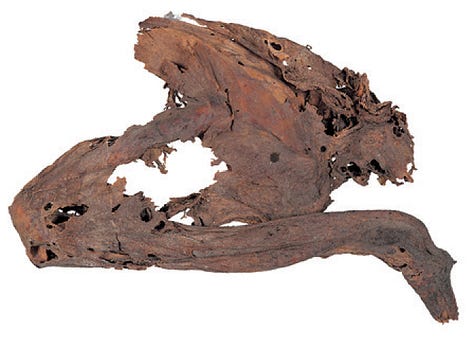Mystery of 'dragon mummy' solved after 600 years
True nature of Japanese royal treasure exposed by new study
THE mystery of a mummified “rainbow dragon” stashed among the treasures of the Japanese royal family has been solved after nearly 600 years.
The enigmatic remains at the Shosoin Treasure House in Nara, Japan, were reputedly found by the shogun, Yoshinori Ashikaga, in 1429.
During a visit to Nara’s Todaiji temple, he’s said to have cut a piece from the Ranjatai – a rare and treasured piece of agarwood.
It was then, a monk at the temple recorded, that he “saw something in the shape of a small dragon” dried by the sun.
Now a new study has revealed the creature’s true nature using X-ray technology and radiocarbon dating.
Close comparison with known species found that the “dragon” was in fact a Japanese marten, a weasel-like mammal.
The authors wrote: “The two premolars are clearly visible, and this characteristic indicates that it is a species of the Martes genus.”
It was likely a full-grown female, they added, measuring 40cm in length.
Radiocarbon testing shows the remains date from the mid-11th to the mid-12th century – a time when the repository faced multiple repairs.
It’s therefore thought the animal may have entered the building during repairs, got trapped, and died, before becoming mummified and added to the collection.



Conversely, it could have been brought in deliberately – since the specimen is missing its forelegs and they have never been located.
Co-author Minoru Yoneda of the University of Tokyo said: "We measured the radiocarbon age of three small tissue fragments that had fallen off the treasure.
"The ages of the three samples showed good agreement, ranging from the 11th to 12th centuries.
RELATED ARTICLES
Mystery of 'mermaid mummy' solved?
Mystery creature caught on camera sparks 'chupacabra' claims
‘Alien’ creature that’s a mix of ‘snake, large intestine and condom’ discovered by disgusted holidaymaker
"It is believed that these are not artifacts stored when the Shosoin was opened, but rather remains brought in later or from animals that entered the facility."
According to legend, after the “dragon” was added to the treasure house, it would rain every time the repository was opened.
During the course of the study, the legend would prove eerily prescient.






At one point, researchers from Tokyo were forced to reschedule their visit after heavy rains caused their bullet train to be cancelled.
Conservationist Mami Tsuru of the Shosoin Treasure House said she believed the “dragon” to be the same one found by Yoshinori Ashikaga.
She said: “The age determination has significantly increased the possibility that the mummy is the sun-dried dragon-looking object recorded in the document from the Muromachi Period”.
She added: “We believe this is a good example of how Shosoin has protected not only beautiful items, but also all the items inside the repository.”


Other “dragons” in the collection were also analysed and found to be parts of a Kobe mole, crow, and pigeon respectively.
The study includes contributions from the National Museum of Nature and Science and the University Museum of the University of Tokyo.
It was published in the 47th Bulletin of Office of the Shosoin Treasure House.







